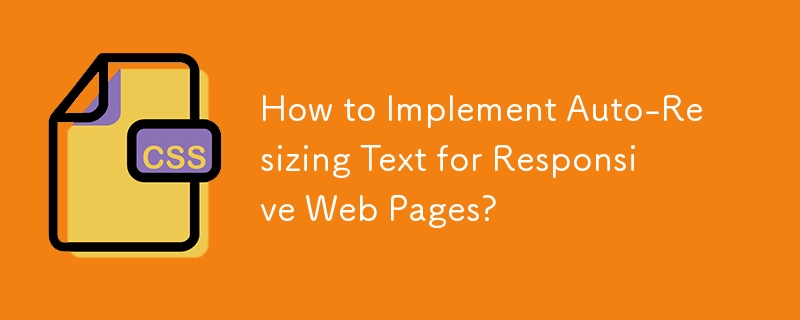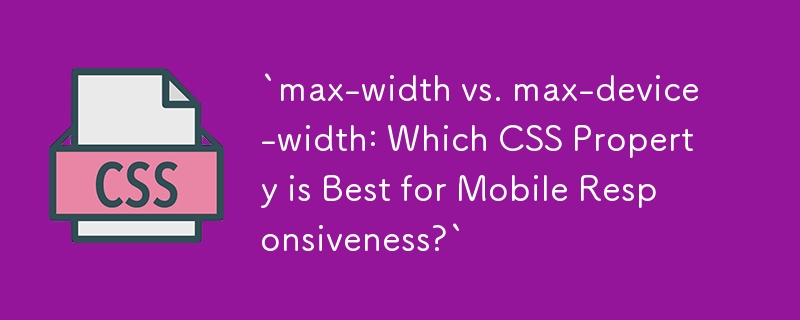Found a total of 10000 related content

HTML Audio and Video: The Complete Tutorial
Article Introduction:Using audio and video in web pages is important because they expand expressiveness and enhance user experience. 1. Audio tags are used for background music, podcasts, etc., and must specify the source, automatic playback and controls. 2. Video tags are used for product introduction, educational courses, etc., and must specify the source, width and height, automatic playback and loop playback. 3. Optimization strategies include compressing files, using WebM format, avoiding automatic playback, and providing clear controls. 4. Use elements to add subtitles to improve accessibility. 5. Best practices include responsive design and SEO optimization.
2025-06-26
comment 0
238


How to Implement Auto-Resizing Text for Responsive Web Pages?
Article Introduction:This guide demonstrates how to achieve auto-resizing text in responsive web pages using a combination of CSS and jQuery to ensure that text seamlessly adjusts to different window sizes, providing users with an optimal reading experience across device
2024-10-24
comment 0
854

How to Manage Input Widths in Bootstrap 3?
Article Introduction:Managing Input Widths with Bootstrap 3Bootstrap 3 provides a comprehensive framework for creating responsive and visually appealing web pages....
2024-11-05
comment 0
848




What is H5?
Article Introduction:H5, the abbreviation of HTML5, is a web development technology that supports mobile adaptation, touch interaction and multimedia functions. It is widely used in scenarios such as corporate publicity, marketing activities, data collection and education and training, such as fun tests, raffle pages, questionnaires and online courses. Compared with traditional web pages, H5 is more suitable for mobile browsing, and has responsive layout, offline caching and device information acquisition capabilities. The production of H5 can be quickly built through template platforms such as "Yiqixiu" and "Ruzhan", or developed by itself through HTML, CSS, JavaScript and other technologies, and attention should be paid to loading speed and compatibility testing.
2025-07-09
comment 0
305

How to Dynamically Scale Text Element Sizes on Window Resize
Article Introduction:This article presents a method for dynamically scaling text elements in web pages to adjust to browser window resizing. It discusses the limitations of using CSS for text scaling and proposes a JavaScript solution using jQuery to achieve a responsive
2024-10-24
comment 0
941

Getting Started with HTML Tables
Article Introduction:HTML Forms: A Guide to Creating Responsive and Mobile-Friendly Forms
HTML tables are used to display table data on web pages. They are great for displaying information in an organized way and can be styled using CSS to match the look and style of a website. This tutorial will cover the basics of creating HTML tables and adding styles to make them responsive and mobile-friendly.
Key Points
HTML tables are powerful tools for displaying table data on web pages, and can create tables, rows, and cells using and tags.
The style setting of HTML tables can be achieved through CSS properties such as borders, fills, background colors, and media queries for different screen sizes, making them responsive and mobile-friendly.
Can be added by
2025-02-09
comment 0
357

How to solve the h5 compatibility problem
Article Introduction:Solutions to H5 compatibility issues include: using responsive design that allows web pages to adjust layouts according to screen size. Use cross-browser testing tools to test compatibility before release. Use Polyfill to provide support for new APIs for older browsers. Follow web standards and use effective code and best practices. Use CSS preprocessors to simplify CSS code and improve readability. Optimize images, reduce web page size and speed up loading. Enable HTTPS to ensure the security of the website.
2025-04-06
comment 0
399

What is the viewport meta tag for responsive design?
Article Introduction:viewportmetatag is the key to responsive design, which controls how web pages are displayed on mobile devices. It ensures that the web page is correctly adapted to the screen by setting the viewport width to the device and disabling initial scaling. Common problems such as too small pages and confusing layouts may be caused by not setting the viewport correctly. The basic writing method is: You can also add parameters such as maximum-scale=1 and user-scalable=no according to your needs, but you need to pay attention to their impact on user experience. Correct use of viewport is the basis for implementing responsive design, and none of them are missing.
2025-07-17
comment 0
423

How to view Bootstrap results on different devices
Article Introduction:Bootstrap's responsive design uses media queries to adjust the page layout according to the device's screen size, so that web pages can be displayed elegantly under different sizes. Users can perform more granular control through custom media queries, such as using different layouts under different screen sizes. The code needs to be tested, previewed on different devices, and constantly adjusted for optimal rendering.
2025-04-07
comment 0
533

How to debug a website on an iPhone using Chrome on a PC
Article Introduction:To debug web pages on iPhone, you can use Safari remote debugging, vConsole or simulate UA; 1. Use Mac Safari to open the development menu and connect to the iPhone for remote debugging; 2. Introduce the vConsole debug library to view logs and network requests; 3. Use ChromeDevTools to simulate iPhone screen size and user agent to test responsive layout.
2025-07-12
comment 0
275

The Meaning and Purpose of Responsive Web Design
Article Introduction:Responsive web design: adapted to all screens
Responsive web design (RWD) is a design method that allows a website to adapt to screens of all sizes and is essential to support an increasing number of devices for browsing web pages.
RWD follows the development principle of "Don't Repeat Yourself" (DRY) and aims to use a set of code to fit each device. This means writing a set of HTML, CSS, and JavaScript code and displaying elements appropriately for each platform.
There are a number of different design concepts for RWD memory, including progressive enhancement, elegant downgrades, and mobile priority. These approaches focus on different aspects, such as providing content to all users, starting with the full version of the website, or from the smallest or weakest subsidiaries, respectively
2025-02-17
comment 0
390

How to optimize images for web
Article Introduction:The core of optimizing images for web pages is to balance quality and loading speed. The key steps include: 1. Select a suitable format such as JPEG, PNG, WebP and SVG; 2. Control the size and resolution and crop according to the display area; 3. Use lossy or lossless compression to reduce volume; 4. Apply lazy loading and responsive image technology to improve loading efficiency.
2025-06-30
comment 0
557

How to Install Java on Mac with M3, M2, M1 Apple Silicon Chip
Article Introduction:Some Mac users may need to install Java on a Mac equipped with Apple Silicon, whether it is M1, M2, M3, or other M-series ARM chips, in order to run Java-based applications and software on their computers. Whether it is to run specific enterprise software, use specific educational tools and computer science courses, run Java web applications, or access and use Java development tools and JDK (Java Development Kit), installing Java is necessary on MacOS, although Java is usually only required by advanced users and developers. Modern Mac and modern versions of MacOS do not include Java by default and have been around for quite some time, so if
2025-05-16
comment 0
604

What can be done for H5 page production
Article Introduction:H5 page production is not only suitable for creating simple web pages, but also has powerful functions, including: Dynamic interaction: Use elements such as animation, video and 3D models to provide users with an immersive experience. Mobile-friendly: Responsive design ensures the best browsing experience on a variety of devices. Data visualization: present data in an intuitive way, using elements such as charts and maps. Games and interactive applications: Develop lightweight games and interactive applications to enhance user engagement. Cross-platform compatibility: Based on a combination of HTML5, CSS3 and JavaScript, but compatibility remains a challenge. Performance optimization: For complex pages, code efficiency needs to be optimized. Security: Security vulnerabilities need to be prevented, such as
2025-04-06
comment 0
573

Decoding CSS Positioning: A Master Class with Paul O'Brien
Article Introduction:CSS Positioning: The key to proficient in web layout
CSS positioning is a basic concept in web development, which gives developers the ability to control how HTML elements are displayed on web pages. Understanding CSS positioning is essential to creating responsive and visually engaging web designs.
CSS expert Paul O’Brien stressed that there are usually multiple ways to implement CSS layouts, and the best solution often depends on subsequent requirements. The challenge for beginners is how to choose the right method that suits the current task.
In the dCode forum, Paul O’Brien explores CSS positioning in depth and answers various questions, covering floating, relative positioning, absolute positioning, fixed positioning, table display and
2025-02-18
comment 0
1053



















